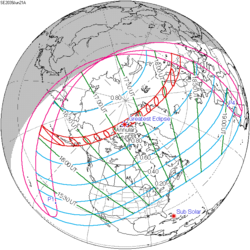| Partial eclipse | |
| Gamma | 1.072 |
|---|---|
| Magnitude | 0.8406 |
| Maximum eclipse | |
| Coordinates | 63°12′N81°06′E / 63.2°N 81.1°E |
| Times (UTC) | |
| Greatest eclipse | 21:29:38 |
| References | |
| Saros | 147 (21 of 80) |
| Catalog # (SE5000) | 9476 |
A partial solar eclipse occurred at the Moon's ascending node of orbit between Sunday, May 19 and Monday, May 20, 1985, [1] with a magnitude of 0.8406. A solar eclipse occurs when the Moon passes between Earth and the Sun, thereby totally or partly obscuring the image of the Sun for a viewer on Earth. A partial solar eclipse occurs in the polar regions of the Earth when the center of the Moon's shadow misses the Earth.
Contents
- Eclipse details
- Eclipse season
- Related eclipses
- Eclipses in 1985
- Metonic
- Tzolkinex
- Half-Saros
- Tritos
- Solar Saros 147
- Inex
- Triad
- Solar eclipses of 1982–1985
- Saros 147
- Metonic series
- Tritos series
- Inex series
- References
- External links
A partial eclipse was visible near sunrise on May 20 over Japan and northeast Russia and ended on May 19 over Alaska and near sunset over northern Canada and Greenland.































































































